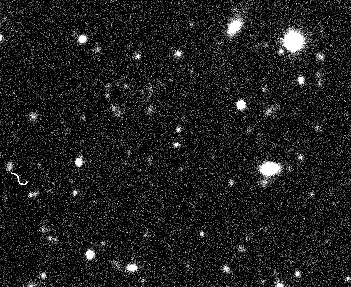
| TWELVE NEW MOONS FOR SATURN - 2005 May 03 |
|---|
SUMMARY
Minor Planet Electronic Circular MPEC J13 (2005 May 03) and IAU
Circular 8523 (May 04) report the discovery of 12 previously unknown
satellites of Saturn, nearly doubling the number of known irregular
satellites and bringing the total number of moons of that planet to
46. The discoveries were made as part of a long-term and highly
productive program to explore the planetary satellite systems using the
world's largest telescopes atop Mauna Kea, Hawaii.
DETAILS
The satellites were discovered on December 12, 2004 using the
wide-field SuprimeCam
camera on the 8.2-meter diameter Subaru telescope on Mauna Kea. They
were followed up in January, February and March 2005 using the combined
power of Subaru and
the nearby
8-m diameter Gemini
North and Keck 10-m telescopes [see
Sample Images]
The orbital elements were computed by Brian Marsden of the IAU Minor Planet Center at the Center for Astrophysics, and are given in Table 1. All but one (S/2004 S11) orbit Saturn in a direction opposite to the planet's spin. These retrograde orbits are a hallmark of an origin by capture. The new moons range in diameter from about 3 km to 7 km, assuming a surface albedo of 4%.
Figure 1: New irregular satellite S/2004 S11 is located in the center of this 3-image blink sequence from the Subaru telescope. The satellite moves nearly vertically in these images (East is to the top, North to the right), which are separated in time by about 1/2 hour. Background stars and galaxies remain fixed. Objects which appear in only one image are cosmic ray hits, noise spikes and/or image defects. Click the image for a larger view. If you can't find the satellite, here's a cheat sheet.
SCIENCE
These new discoveries improve our knowledge of the satellite system and
should, eventually, lead to an understanding of the
origin
of the irregular satellites. Already we have found that the most studied
capture model offers no explanation for the systematics of the irregular satellite
populations. Most surprisingly, we have found that the four giant planets
all possess about the same number of irregular satellites when measured
down to a given size, independent of planet mass, location, or formation
mode. This observation remains unexplained.
THE FACILITIES
RELATED LINKS
CONTACTS
| Irregular Satellites |
|---|